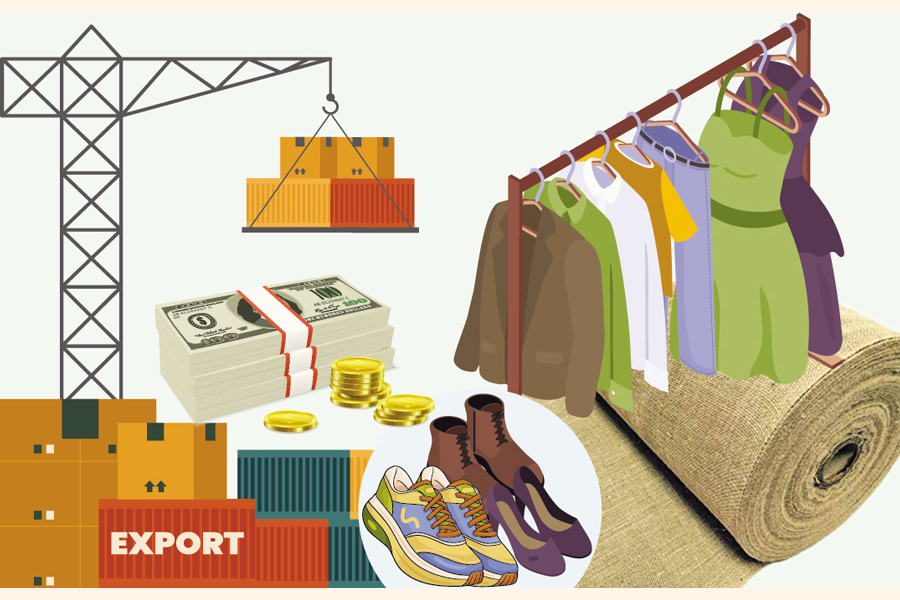
Published :
Updated :

It is never wise to put all eggs in one basket where a single misstep can cause them all to break. A nation's "basket" is its export profile and over-reliance on a single sector makes it vulnerable to volatile global demand. Yet despite decades of discussion and repeated calls for diversification, Bangladesh's export structure has shifted very little since it first entered global markets. The decline of jute and jute goods from their once-dominant position did not trigger any meaningful broadening of the export base either. Instead, export concentration simply shifted to a narrow set of new products. Today, a handful of goods make up most of the export basket and a limited number of markets continue to absorb the bulk of what Bangladesh sends abroad.
Over the past few decades, readymade garments came to define Bangladesh's export identity and it still influences where Bangladeshi products can reach. While some nations have moved away from apparel manufacturing and now import from Bangladesh, many others still produce their own garments and have limited demand for our supplies. But because the garment sector already guarantees a dependable global market, they draw most of the focus, leaving other exportable products without the push they need to grow. Until new products establish themselves, the expansion of destinations will continue to be limited. It is in this context that the recent gains in a few non-traditional sectors should be judged. Rather than signalling a sudden transformation, these trends highlight how long Bangladesh has waited for industries beyond apparel to gain a solid foothold. The toy industry and the wider plastics sector provide examples of what might have emerged much earlier and on a much bigger scale had there been sustained investment and consistent policy commitment.
Recent figures show that toy exports could grow more than eightfold within the next five years, a pace that would have seemed unthinkable not long ago. In 2022-2023, toys from Bangladesh reached 88 countries and earned more than US$75 million. Projections now suggest that by 2030 this amount could climb to nearly $470 million. If Bangladesh stays on this path, it could even break into the ranks of the world's top 30 toy exporters soon. At home, plastics now serve a massive domestic market worth Tk 400 billion. The industry contributes about Tk 35 billion in annual revenue and supports nearly 5,000 factories, most of which are small and medium enterprises that form the backbone of our local economy. This goes to show that there are industries in Bangladesh with genuine potential, ready to grow if given the right support.
That said, the success of toys and plastic, impressive as it is, doesn't change the fact that they remain isolated examples within an export basket still heavily dominated by one sector. The clearest evidence of this is that readymade garments continue to account for more than 82 per cent of export earnings. Policymakers and business leaders have acknowledged the need for a broader product base and more diverse destinations but this shift has not taken place. Businesses have simply responded to the incentives and market conditions in front of them, and those conditions have kept garments at the centre of the export earnings.
This overconcentration doesn't stop with products but it extends to markets as well. Nearly two thirds still go to Europe and the United States for reasons understandable. According to the Export Promotion Bureau, 44 per cent of all exports go to the European Union alone because tariff-free and quota-free access is still available for least developed countries. Even as Bangladesh achieved a record $48 billion in exports last year, the share going to these two markets declined only slightly from 65 per cent to 62 per cent over three years. Taken together, these trends show how firmly set our reliance has become. A few emerging sectors, promising as they are, cannot change this underlying vulnerability. Without real diversification, Bangladesh will continue to depend on a small and fragile group of markets which keeps the economy exposed in ways that have persisted for years.
Thus far, the range of exportable goods remains critically narrow, which is why non-apparel products have struggled to gain significant traction in new markets. When the list of products is small, the list of markets naturally stays small too, no matter how often diversification is discussed. This basic issue also explains why cash incentives for non-traditional exports have yielded only modest results. Today, these incentives cover more than 40 products, with garment exporters receiving an additional two per cent for shipments beyond the main markets of Europe, North America and the UK. Yet analysts are far from unanimous on how effective these measures really are. Because garments dominate the export structure so heavily, most of the incentives inevitably end up in that single sector. Many experts argue that support should instead target specific products and specific destinations where progress can be clearly tracked, rather than being shaped by pressure from powerful industry groups.
Outside the garment sector, most industries face a different set of challenges. Many struggle to meet international quality and certification standards while weak domestic testing and accreditation systems slow down market entry and drive up costs. High logistics expenses, chronic congestion and inefficient transport networks further weaken competitiveness. On top of that, the absence of free trade agreements blocks access to lower tariff rates in potential new markets. These barriers must be removed.
The journey towards a more diverse export economy is challenging but it cannot be avoided. If Bangladesh wants lasting economic stability, the vision of diversification must move beyond rhetoric and translate into decisive action. The rise of the toy industry is a proof that steady effort can pay off. Applying the same commitment to other promising sectors is the surest way to build a balanced and resilient export future.
showaib434@gmail.com


 For all latest news, follow The Financial Express Google News channel.
For all latest news, follow The Financial Express Google News channel.